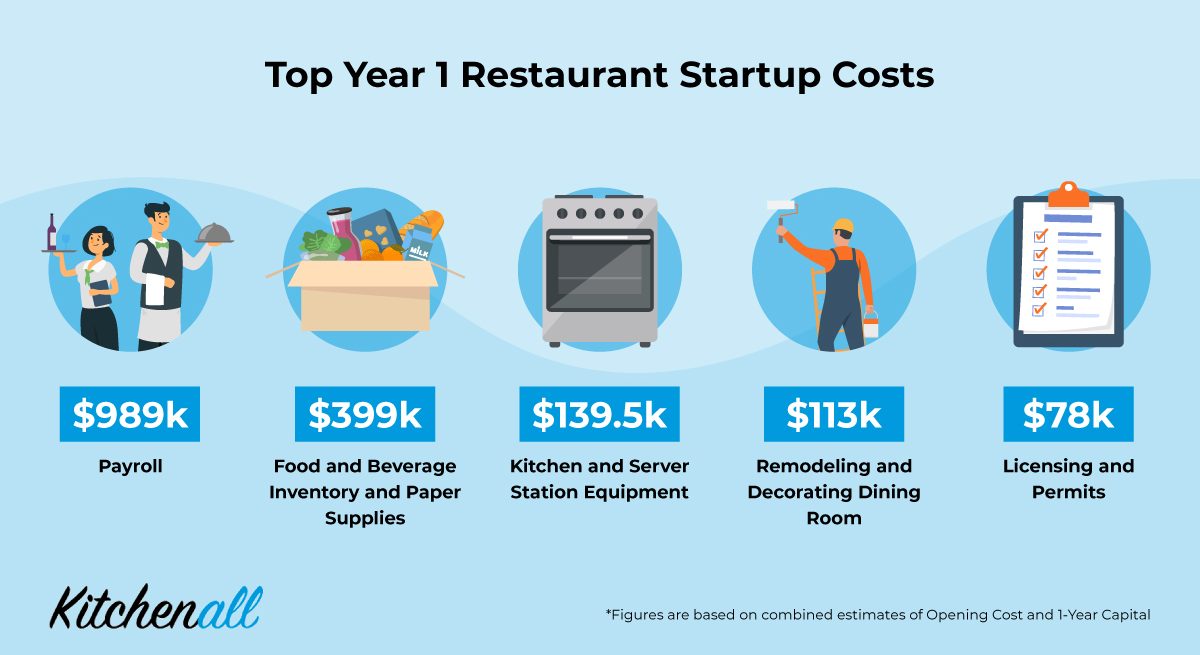The Top Five Startup Costs Restaurant Owners Need to Know
3 Min Read By Gary Magnone
If you’re planning on starting a restaurant, you are probably looking forward to a packed dining room, happy guests, and empty plates; however, it also takes a lot of money to get your restaurant off the ground. That’s why you have to be aware of some of the upfront costs you’ll face before you open your doors.
Recently, our team at Kitchenall conducted a study taking a look at the biggest startup costs associated with opening a new restaurant. Learn more about the top five startup costs all restaurant owners need to know about.
1. Payroll
Without a doubt, one of your biggest expenses is going to be payroll. If you don’t keep a close eye on your payroll, it can get out of control. Labor costs can vary depending on the type of restaurant you run. In general, you should try to keep your payroll expenses to 20 to 25 percent of your maximum profit. Remember that it can also be expensive to hire and train new employees. Therefore, if you have exceptional employees at your restaurant, do everything you can to keep them around. Make sure you do a projection and daily audit to ensure your payroll costs are commensurate with your current revenue.
2. Food and Beverage Inventory and Paper Supplies
Similar to your payroll expenses, your food and beverage expenses are going to vary depending on the type of restaurant you run. In general, overhead expenses related to food and beverages should be between 35 and 40 percent of your total revenue. If you want the restaurant to be profitable, then your food expenses should be closer to 30 percent of your total revenue. Then, you need to think about paper supplies as well. For example, the cost related to printing menus can also be expensive. If your food items rotate regularly (such as with seafood), you might find yourself spending more money on menu printing than you would like.
3. Kitchen and Serving Station Equipment
There is no way you can prepare a meal without the right equipment. You need to have ovens, grills, refrigerators, and freezers. You may also need specialized serving stations as well. The price tag can blindside you if you are not ready, so you need to think carefully about the equipment you need to open your door. Remember that you may need to pay additional costs to have the equipment installed, so budget accordingly. Depending on the type of restaurant you run, you may need to purchase more equipment as the restaurant gets going.
4. Remodeling and Decorating Expenses
Whether you are building your own restaurant from the ground up or taking over a restaurant that used to be run by someone else, you may need to remodel the kitchen and dining room. Different types of dishes require different types of layouts, and you need to make sure the dining area matches the type of food you are serving. You may need to demolish walls, install new furniture, and replace the art on the wall. Then, you may want to include a fish tank or add special lighting. The expenses related to remodeling your kitchen and dining room can vary widely from place to place. Fortunately, once you are done with the remodeling process, you should not have any other expenses related to redesign issues in the near future.
5. Licensing and Permits
Before you can open your restaurant, you need to have the right licensing and permit. First, you need to get your employee identification number (EIN). You cannot get any licenses or permits without your EIN. Then, you need to get your business license, which you get from the local city or county. You also need to contact the Alcoholic Beverage Control board for your liquid license. Finally, you also need to get your foodservice permit as well as your signage permit. These expenses can add up quickly, and you may need to pay additional money to renew these licenses every year. Make sure you do not overlook these expenses.
Calculate Expenses While Building Your Business Plan
Even though it is fulfilling to build a restaurant from the ground up, it is also an expensive process. You need to be aware of some of the expenses you will face during the first year so you can budget accordingly. If you overlook these expenses, you can get blindsided by significant bills down the road that could make it difficult for you to keep your doors open. That’s why we highly recommend using tools like a cost calculator or checklist while you build our your business plan to make sure you’re prepared when raising money and securing funding.


